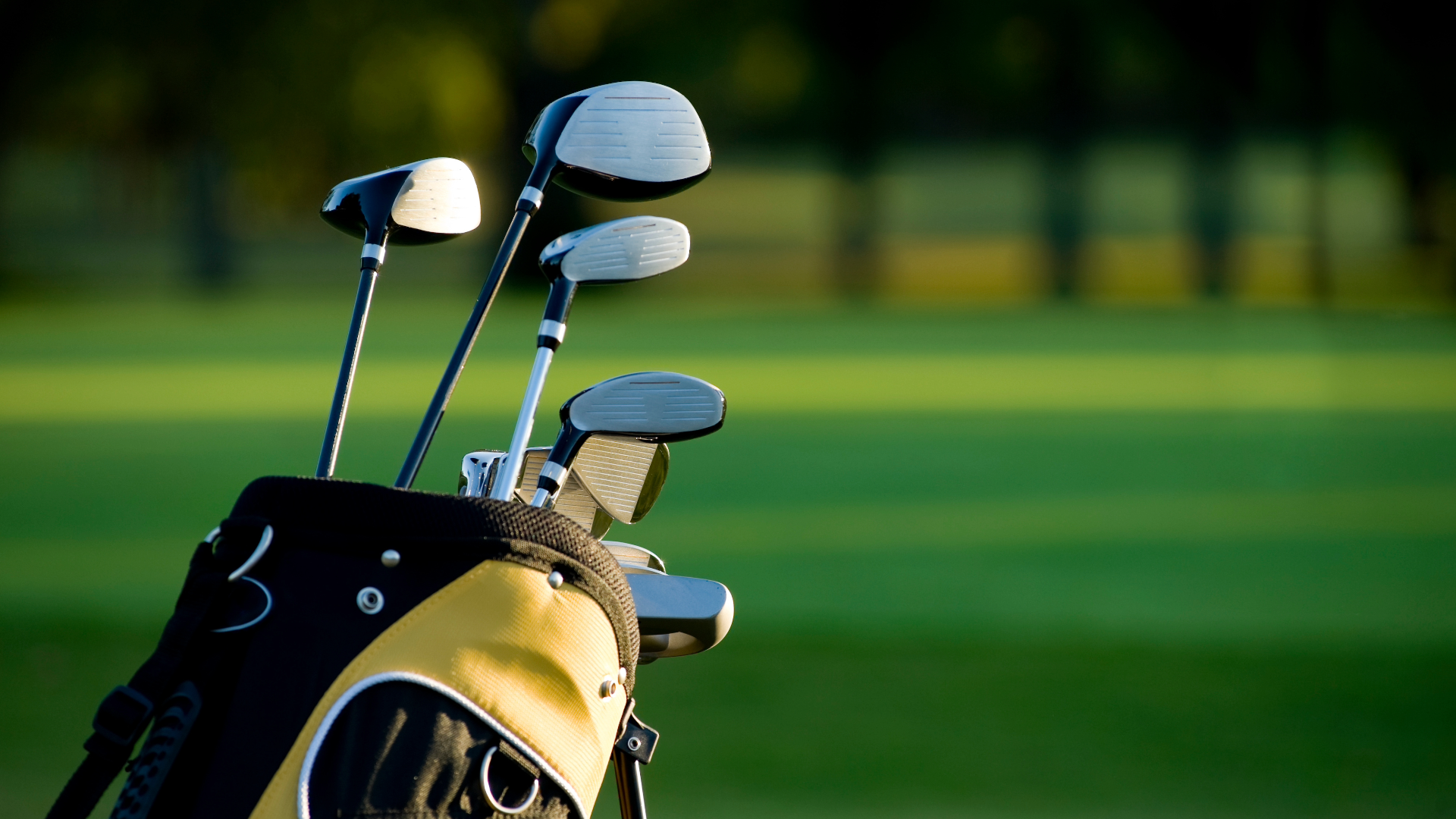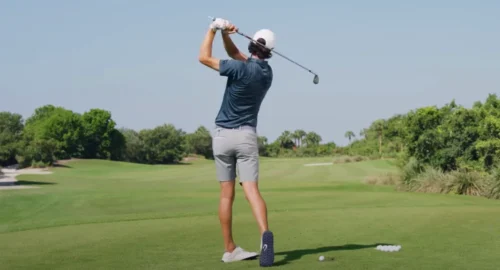
Golf can be a relaxing and enjoyable sport, but can often be very overwhelming for beginners. Not only mastering technique and the swing itself but also the plethora of equipment and jargon used on the golf course.
Luckily, we’ve crafted an epic list of the best golf terms to help you understand the basics, even if you’re a beginner golfer.
We’ll cover all sorts of terms from different types of equipment, rules, scoring, and common golf slang. Think of this as the golf glossary for beginner golfers.
Golf Equipment Terms
Before getting to different terms on the golf course and common slang, let’s start with equipment. Each golfer is allowed to have 14 clubs in the bag according to the United States Golf Association but can have fewer as well if they desire.
Here are the clubs that make up a set.
1. Driver
A driver is the longest club in the bag with the biggest club head – it’s used for a tee shot on most holes.
It’s one of the most fun clubs to hit as its purpose is to hit long distances. However, the longer length also makes it one of the most difficult clubs to use consistently in golf.
2. Fairway Woods
The next longest golf clubs are known as fairway woods.
These clubs are smaller than a driver and used for a variety of shots. Since they have a smaller club head and are shorter than a driver, they’re also much easier to hit.
Pretty much every golfer carries a 3-wood, most carry a 5-wood, and others carry higher-lofted woods (7-wood, 9-wood, and/or a heavenwood).
3. Hybrids
A newer type of golf club style is known as hybrids. These clubs are part fairway wood, part iron, earning them the “hybrid” name.
They have the forgiveness of a fairway wood with the control of an iron. These clubs are very popular among amateur golfers as they’re much easier to hit consistently well.
4. Irons
Irons are the clubs that make up most sets. There are different types from 1 to 9 iron – the lower the number, the longer the club and a lower loft.
For example, a 4-iron has less loft than an 8 or 9-iron. Longer irons go further but are also harder to hit, especially for newer golfers.
5. Wedges
The last few clubs that make up a complete set are known as wedges. These clubs have more loft than irons and are shorter, making them easier to hit straighter.
Wedges are used for both full-swing golf shots and short-game shots around the green. Every iron set comes with a pitching wedge (PW) and golfers tend to add a gap wedge (GW), sand wedge (SW), and/or lob wedge (LW) as well.
6. Putter
The last club in the bag is a putter which is used to get the ball in the hole on the greens. This is the shortest club in the bag and there are different styles, such as blades or mallets.

7. Training Aids
Training aids are pieces of equipment that help golfers improve specific areas of their golf swing. Some training aids help takeaway (like the StraightAway), others help with tempo, and others help with the swing path.
8. Alignment Sticks
Alignment sticks (also known as alignment rods) are shafts without clubheads that are used to help players line up properly. These are great for golf practice at the driving range and a staple in most golfers’ bags.
9. Divot Tools
Another staple in every golf bag is a divot repair tool. These small devices help golfers repair their divots to allow the grass to heal properly.
Scoring and Rules
Now that you have a good understanding of the clubs used in golf, let’s address scoring and rules. These are some of the most confusing golf terms for players so make sure you know these if you plan to become a seasoned golfer.
10. Stroke Play vs. Match Play
Stroke play is how most rounds are scored in a round of golf; every shot counts from tee to green. You add up the number of strokes on the hole and mark it on the scorecard.
Match play is a different format where one person is only playing golf vs. one other person (or team). They can only win or lose by one on a hole, despite the stroke differential. This type of format puts a premium on tee shots and makes for a fun round of golf.
11. Ace/Hole in One
An ace is commonly referred to as a hole in one, and is one of the greatest achievements in golf.
Studies have shown that the odds of a good player making a hole-in-one are 12,500 to one! It’s so rare that many players go their whole career without achieving it.
13. Par
Par is one of the most common terms in golf. It refers to the difficulty of each hole and how many shots it should take to get the ball in the hole.
There are three types of holes; par 3s, par 4s, and par 5s.
Par 3s are the shortest holes and the ones where an ace is most likely. A par 4 is a longer hole that requires two shots to get on the green. A par 5 is an even longer hole that requires three but sometimes less shots to get on the green.
Full-length championship golf courses are typically par 70-72 for 18 holes. There is a mix of par 3s, par 4s, and par 5s that vary in distance.
14. Eagle
Eagle is a term that means a golfer shoots two under par on a hole. For example, if a hole is a par 5, an eagle would be a score of three on the hole.
These shots are much more likely than an ace but still not a common occurrence among amateur golfers. There is a variation known as a double eagle (also known as an albatross) where a golfer scores three under on a hole (ex. Getting a score of two on a par 5).
15. Birdie
A birdie is a much more common scoring term in golf. This score represents one under on a hole.
If the hole is a par 3, a birdie would be a score of two on the hole.
16. Bogey
The opposite of a birdie is a bogey which represents scoring one over on the hole. For example, if a golfer scores a six on a par 5.
Other versions of this term include a double bogey (two over), triple bogey (three over), and quadruple bogey (four over). Some players might say they “play bogey golf” meaning they average about a bogey a hole (roughly a score of 90).
17. Snowman
A snowman is a funny golf scoring term that means a golfer made an eight (8) on the hole. Since the number eight looks like a snowman, this term is not a score any golfer wants to make as it represents a triple bogey or worse.
18. Gimme
This is a short putt that is conceded by fellow players – no putting stroke required. These putts tend to be inside a putter’s length (usually inside 2–3 feet).
19. Scratch Golfer
A scratch golfer (referred to as a “scratch”) is someone who shoots around par for the course. This is a top goal for most golfers and is also referred to as a person with a zero handicap.
Golf Swing Terms
Next up is swing terms; which there is no shortage of in the golf world.
20. Slice
A slice is one of the most common and frustrating shots in golf. A slice means the golf ball curves from left to right in the air (for a right-handed player).
It’s common to hear golfers say “banana slice” if it has a lot of left-to-right movement. Other variations include push slice or pull slice as well.
21. Fade
A fade – often referred to as a “cut shot” – is a smaller variation of a slice.
This shot moves the golf ball left to right in the air but only a few yards. It’s a much more playable shot and easier to control than a draw or hook (below).
22. Hook
A hook shot is the opposite of a slice in golf. A hook refers to a golf ball that curves from right to left in the air (for a right-handed player).
Other common variations of this golf shot include duck hook, push hook, or pull hook.
23. Draw
A draw is the opposite of a fade and is when the golf ball moves right to left in the air but only a few yards. This shot is a desired shot shape among golfers as it’s not as common as a fade or draw.
24. Putt
A putt is when you’re on the green (near the hole) and use a putter. The fewer putts the better!
25. Lip Out
A lip out is when a putt is about to drop and goes in a portion of the hole, only to spin out. Another similar golf term is burned edge where the ball burns the edge of the cup but doesn’t go in the hole.
26. Topped Shot
A topped shot is when a golfer only hits the top portion of the ball and doesn’t go very far. A top can go a few yards or if it has a lot of topspin can go 20-30+ yards.
27. Pop Up
A pop-up shot is when a golfer hits the ball with a downward angle that the ball shoots straight up in the air – similar to baseball. These shots are also as frustrating as a topped shot and can leave a skymark (which is a nasty scratch/chip on the top of the club).
Golf Course Terms
Let’s cover next the different golf course terms that are frequently used during a round.
28. Caddy
A caddy (or caddie) is a person a golfer hires to assist them during the round. This is one of the oldest jobs in golf and is much more common in professional golf than amateur golf.
A caddy has different responsibilities during the round: cleaning clubs, raking sand traps, reading greens, removing flag sticks, providing player advice, and a lot more. Playing with a caddy is a fun experience and can lead to lower scores.
29. Driving Range
This refers to the practice area where golfers hit before the round or during practice sessions. This is a large area with grass teeing area (or mats) and designed to help players work on their game.
Driving ranges typically have nets on both sides and one on the end to catch golf balls. If you’ve been to TopGolf, you’ve been to a driving range.
30. Tee Box
A tee box is the starting point of the hole. There are usually 3-5 tee boxes on each hole, depending on the golf course.
From this position, a golfer can insert a tee into the ground and must hit behind the markers to avoid a penalty stroke.
31. Fairway
A fairway is the desired landing area for a golf shot from the tee ground. This grass is mowed down and easier to hit from than the rough or sand.
On most golf courses there are 14 fairways to hit in regulation (there are no fairways on par 3 golf holes).
32. Rough
If a golfer misses the fairway they’re likely in the rough. This is thicker, longer grass that is more complicated to hit from than the low-cut fairway.
Each golf course is different in terms of rough length and some courses have different “cuts” of rough. Golfers try to avoid the rough as clubs get twisted in the thicker grass and can lead to errant shots.
33. Bunker / Sand Trap
The term bunker refers to sand on the course (known as sand traps). Bunkers are scattered throughout the golf course and golfers try to avoid ending up in these areas as they can be complicated shots.
There are two types; fairway and greenside bunkers.
Fairway bunkers occur on par 4s or par 5s and are more flat, making them easier to escape. Greenside bunkers occur on most holes near the green and require a sand or lob wedge to get out of the sand trap.
34. Putting Green / Putting Surface
This is the area where golfers use a putter to try and get the ball in the hole. Grass is cut the shortest and greens are measured in terms of speed.
Most golf courses have a 9-10 speed while professional golfers play on faster greens that are 11-13 speed.
35. Fringe
The fringe is the area around the green that is slightly longer grass than the putting surface. Players can choose to putt from the fringe, pitch, or chip.
36. Lie
A lie is a term that refers to how the golf ball is lying on the course. A bad lie might mean it’s in a bunker, under a bush, or in a divot.
Common bad lies in golf include:
- Embedded: This is when a golf ball goes into the ground (not the sand) and golfers are allowed a free drop.
- Fried egg: This is when part of the golf ball is below the surface of the sand making it one of the trickier shots in golf.
- Plugged: This is when the golf ball plugs in the sand and only a portion of it is visible.
37. OB – Out of Bounds
When a golfer hits OB they must hit the previous shot again. OB refers to any area that is out of bounds and not playable.
When a player hits OB they have to take a two-shot penalty. For example, if a player hits out on their tee shot, they’ll need to tee off and hit their third shot on the hole.
38. Provisional Ball
A back-up shot available to a player if their ball potentially lands out of bounds or is lost after the shot is made.
If the first golf ball is indeed lost, the player can hit their provisional ball instead of going back to the previous spot. This helps ready golf and improve the pace of play. This is more common in a golf tournament setting than casual play.
39. Penalty Areas
Penalty areas are defined by yellow or red stakes. If a ball ends up in this area golfers can play it (if possible) or take relief with penalty strokes.
Golf Slang
Finally, let’s get into the most common funny golf terms for some other terms you’ll hear throughout the round.
40. Mulligan
A mulligan is essentially a do-over of the previous shot (without a penalty stroke). It’s most commonly hit on the first tee shot which is also known as a breakfast ball.
41. Flop
A flop shot is when a player uses a high lofted wedge (usually a sand or lob wedge) to hit a really high shot around the greens. It’s a low-percentage shot but also very impressive if hit correctly.
42. Unplayable
If a ball is deemed unplayable a golfer can take relief using the rules of golf and a one-shot penalty. For example, if a golf ball ends up next to a tree or under a bush, it’s deemed unplayable.
43. Thin/Fat
If a player hits a thin shot (aka skull) it’s low on the face and if it’s really low it might be referred to as a worm burner. If a player hits a fat shot that is high on the face it’s commonly known as a chunk.
44. Waggle
A waggle is a motion that a golfer makes before hitting a shot. It’s a way to keep the arms moving and acts as a trigger to start the backswing.
45. Handicap
A golf handicap refers to a golfer’s ability to score to par. The average male golfer’s handicap is about 14, while the average female golfer’s is about 28.
Handicap is not an average score per round but potential for the person to score. It’s common for golfers to shoot 3–5 shots over the handicap on average.
Each hole on a golf course also has a handicap ranked 1-18. The number one ranked handicap hole is the hardest on the course while the 18th is the easiest hole.
46. Sandbagger
A sandbagger is someone who might not enter all their scores into the handicap system and has a higher handicap than they should. This can be referred to as a term for cheating and one of the worst things a golfer can do.
47. Shank
A shank is a bad golf shot that happens when a player hits the ball off the hosel, not the sweet spot. When this shot happens it goes directly right (for a right-handed golfer) and is considered to be one of the worst golf errors.
48. Fore
Fore is arguably the most important term in golf as it’s something players yell if a golf ball is heading toward them. This helps other golfers duck and find cover to avoid getting hit by an errant shot.
49. First Tee Jitters
This refers to golf nerves that players have on the first tee shot of the day (as it’s often in front of a group of people).
50. Hack/Hacker
You may hear this on or off the course, but it’s not recommended to use as it can be rude. It’s often used to describe a golfer who is, quite frankly, not very good. However, we like to think of it as someone who could simply use some improvement.
Now You’re Ready to Hit the Course!
We hope this extensive list of golf terms will help you understand the wonderful world of golf sooner rather than later. Remember to keep learning, and don’t be afraid to ask fellow golfers if you’re unsure about a rule or term.
If you need help with your golf game, make sure to check out our YouTube channel for tons of helpful tips and fun challenges. If you’re ready for more immersive coaching, check out the extensive training library for coaching on any aspect of the game you’re looking for.

